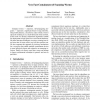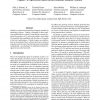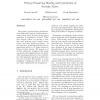USS
2004
14 years 3 months ago
2004
Computer worms -- malicious, self-propagating programs -- represent a significant threat to large networks. One possible defense, containment, seeks to limit a worm's spread ...
USS
2004
14 years 3 months ago
2004
In commonplace textual password schemes, users choose passwords that are easy to recall. Since memorable passwords typically exhibit patterns, they are exploitable by brute-force ...
USS
2004
14 years 3 months ago
2004
Window systems are the primary mediator of user input and output in modern computing systems. They are also a commonly used interprocess communication mechanism. As a result, they...
USS
2004
14 years 3 months ago
2004
Kennell and Jamieson [KJ03] recently introduced the Genuinity system for authenticating trusted software on a remote machine without using trusted hardware. Genuinity relies on ma...
USS
2004
14 years 3 months ago
2004
USS
2004
14 years 3 months ago
2004
A honeypot is a closely monitored network decoy serving several purposes: it can distract adversaries from more valuable machines on a network, can provide early warning about new...
USS
2004
14 years 3 months ago
2004
Copilot is a coprocessor-based kernel integrity monitor for commodity systems. Copilot is designed to detect malicious modifications to a host's kernel and has correctly dete...
USS
2004
14 years 3 months ago
2004
Viruses and other malicious programs are an everincreasing threat to current computer systems. They can cause serious damage and consume countless hours of system administrators&#...
USS
2004
14 years 3 months ago
2004
USS
2004
14 years 3 months ago
2004
Disassembly is the process of recovering a symbolic representation of a program's machine code instructions from its binary representation. Recently, a number of techniques h...



